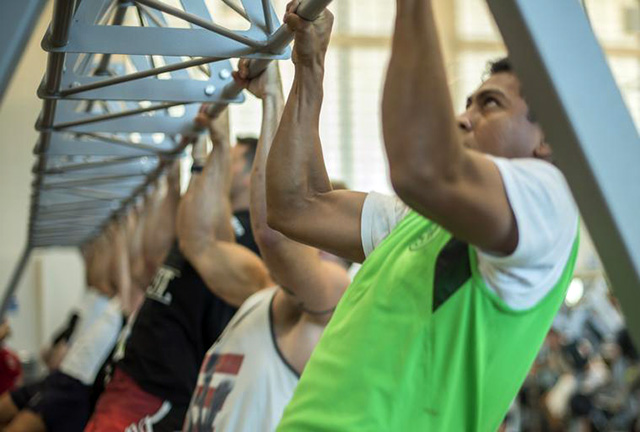The pull up test (also called the chin-up test) is widely used as a measure of upper body strength. Participants must grasp an overhead bar and pull up the body so the chin raises above the bar, then return to the position with the arms fully extended. The following information describes the procedures of this test as used in the President's Challenge, FitnessGram, and Brockport assessments.
test purpose: This test measures upper body muscle strength and endurance.
equipment required: Horizontal overhead bar, set at an adequate height so that the participants can hang from it with their arms fully extended and feet not touching the floor. (see pull-up bars)
pre-test: Explain the test procedures to the subject. Perform screening of health risks and obtain informed consent. Prepare forms and record basic information such as age, height, body weight, gender and test conditions. Measure and record the height of the bar. Perform a standard warm-up. See more details of pre-test procedures.
procedure: Grasp the overhead bar using either an overhand grip (palms facing away from body) or underhand grip (palms facing toward body), with the arms fully extended. The subject then raises the body until the chin clears the top of the bar, then lowers again to a position with the arms fully extended. The pull-ups should be done in a smooth motion. Jerky motions, swinging the body, and kicking or bending the legs are not permitted. As many complete pull-ups as possible are performed.
grip to be used: the Brockport protocol states that the overhand (pronated) grip is to be used (see more about grip types).
scoring: The total number of correctly completed pull-ups is recorded. The type of grip should also be recorded with the results. See these pull-up test norms.
 Chin Up Testing
Chin Up Testingvariations / alternatives:
- There is a similar PFT Pull-Up test and NAPFA pull-up.
- The NAPFA pull-up includes an incline version for younger students, similar to the Modified Pull-Up and Horizontal Pull-Up in which the feet are supported.
- Alternative tests to the pull-up are the flexed-arm hang or push-up test.
target population: sports in which upper body strength is important, such as rowing.
advantages: the equipment is readily available, and this test is easy and quick to perform.
disadvantages: due to variations in technique and whether the arms are extended or the chin reaches the bar, the scoring can be subjective, therefore it is difficult to standardize the results. For those with poor upper body strength, no pull-up may be achieved. For such groups, an alternative test of upper body strength may be appropriate. The body weight of the subject has a great effect on the results of this test.
other comments:
- For some participants, they may need to be lifted up to the starting position. Check for improper technique such as legs swinging or kicking, and failure to fully extend the arms or get the chin over the bar. The participants should be instructed to spend as little time hanging from the bar beforehand as possible as the extra time on the bar may cause fatigue and reduce the number of pull-ups performed. When repeating the test, ensure that the same grip technique is used each time.
- The terms chin-up and pull-up are often used interchangeably, though some people consider that when using the overhand grip (palms facing away from body, pronated grip) it is a pull up, and when using an underhand grip (palms facing toward body, supinated grip) it is a chin up.
The Test in Action
- This test as used in the President's Challenge, FitnessGram, and Brockport assessments.
Similar Tests
- Pull-up procedure from the PFT
- NAPFA pull-up — number in half-a-minute, with an easier horizontal version for females
- Cadence Pull-Up Test — at a rate of 15 per minute
- Horizontal Pull-Up Test — a variation of the hanging pull-up, made easier as the whole body weight does not need to be lifted.
- Modified Pull-Up — with the body horizontal, grasp a bar set just out of reach, and pull up towards the bar.
- Flexed arm hang
- Push-up test
Related Pages
- Where to buy pull-up or chin-up bars.
- Chin up test videos
- Other strength tests
- Pull-up test norms
- POLL: Do you call it a chin-up or pull-up?
- Overhand or underhand - a description of each of the grip types
- More info about the President's Challenge Fitness Awards, the FitnessGram Program, and the Brockport test battery.
- World Records for Chin Ups
- Description of the chin up fitness training exercise


 Current Events
Current Events